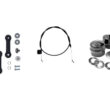Are you considering buying a car? Don’t forget the 1/10th rule! This essential rule states that you should limit your car budget to one-tenth of your total annual earnings. It’s easy to get tempted by fancy cars or financing options, but sticking to this rule has numerous advantages.
Firstly, it helps you avoid excessive monthly car payments that could affect your budget in the long run. Secondly, it reduces your debt-to-income ratio, improving your credit score. And lastly, it allows you to focus on other financial obligations without worrying about extra car expenses.
But that’s not all! Following the 1/10th rule can also help you save money for other significant investments, such as buying a house or starting a business. So, don’t let the temptation of a flashy car lead you astray. Stick to the 1/10th rule and make a smart financial decision.
Understanding the 1/10th rule for car buyers
As a car blogger, I know that buying a car can be an exciting experience. However, it can also be an expensive one, and that’s why it’s essential to have a budget in mind before making a purchase. The 1/10th rule of buying a car is a straightforward and effective way to help you determine how much you should spend on a car. The rule states that you should not spend more than one-tenth of your total annual earnings on a car.
For instance, let’s say you earn $80,000 per year. If you stick to the 1/10th rule, you should limit yourself to spending $8,000 on the purchase of a car. This rule helps ensure that you’re not overspending on a car while still giving you enough money to cover other essential expenses like rent, food, and bills.
The importance of sticking to a budget when buying a car
Sticking to a budget is crucial when buying a car. Overspending on a car purchase can lead to financial difficulties and may even result in you being unable to make payments on time. By setting a budget and sticking to it, you can save money and avoid financial stress.
Furthermore, having a set budget can also help you identify the type of car that’s within your financial means. You’ll be able to narrow down your options and choose a car that fits both your needs and budget. By not overspending on a car, you’ll also have funds left over for other expenses such as maintenance, repairs, and upgrades.
The risks associated with overspending on a car purchase
Overspending on a car can have severe financial consequences. Not only will your monthly payments be higher, but you’ll also be paying more money in interest over the life of the loan. In addition, buying a car that’s beyond your means can also lead to financial stress and may even result in you defaulting on your loan.
Moreover, if you’re unable to make payments on time, your credit score may suffer, and you may find it difficult to obtain credit in the future. It’s important to remember that a car is a depreciating asset, meaning its value decreases significantly over time, and as such, it’s crucial to make a wise financial decision when purchasing one.
Alternatives to buying a new car that fit within the 1/10th rule
If you’re on a tight budget, there are several alternatives to buying a new car that fit within the 1/10th rule. These alternatives include:
Buying a used car – Cars tend to lose their value quickly, so purchasing a used car can be a smart financial decision. You can typically find a used car that’s in good condition and within your budget.
Leasing a car – Leasing a car can be a cost-effective option for those who don’t want to commit to a long-term loan. With a lease, you’ll only pay for the depreciation of the car, which can be a lot less than a traditional loan payment.
Car-sharing services – With car-sharing services, you can rent a car by the hour or day, making it an affordable option for those who don’t drive frequently.
How to calculate a budget for a car purchase using the 1/10th rule
Calculating your car budget using the 1/10th rule is relatively straightforward. Here’s how:
1. Determine your annual income: To calculate your car budget, you must first determine your annual income.
2. Multiply your annual income by 0.10: Multiply your annual income by 0.10 to determine your car budget. For instance, if you earn $80,000 per year, your car budget would be $8,000.
3. Determine additional costs: Keep in mind that there are additional costs associated with car ownership, such as insurance, maintenance, repairs, and fuel costs. These additional costs should be factored into your overall car budget.
Addressing common misconceptions about the 1/10th rule for car buying
There are several misconceptions about the 1/10th rule that need to be addressed. Here are a few:
The rule is too restrictive – While the rule may seem restrictive, it’s essential to remember that a car is a depreciating asset, and spending too much on one can lead to financial difficulties.
The rule doesn’t consider individual circumstances – While the rule may not consider individual circumstances, it’s a great starting point when determining how much to spend on a car.
The rule doesn’t account for loans or financing – While the rule doesn’t account for loans or financing, it’s still essential to consider your monthly payments and the overall cost of financing when determining your car budget.
In conclusion, the 1/10th rule is a simple and effective way to determine how much you should spend on a car. By sticking to a budget, you’ll be able to save money, avoid financial stress, and make a wise financial decision when purchasing a car. Remember to consider alternatives to buying a new car and factor in additional costs associated with car ownership when calculating your car budget.



